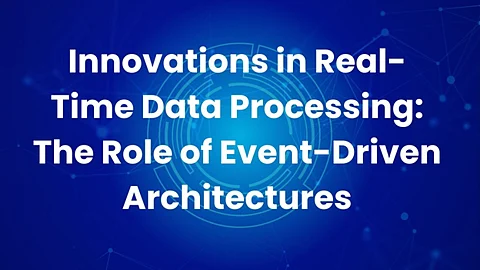

The continuous growth of data generation in today’s digital world has driven a significant shift in how organizations design and process their systems. In the article Event-Driven Architectures: A Comprehensive Analysis of Real-Time System Scalability and Implementation Patterns, Himanshu Adhwaryu explores the transformative potential of Event-Driven Architectures (EDA) in modern system design. By embracing real-time data processing capabilities, companies can achieve unparalleled scalability, operational efficiency, and customer satisfaction, marking a fundamental shift from traditional architectures.
The demand for high-performance systems capable of handling massive amounts of real-time data has never been greater. Traditional monolithic systems, once efficient, are now increasingly inadequate to manage the ever-growing volume and velocity of modern data. As businesses adopt cloud technologies and scalable solutions, the limitations of monolithic architectures have become evident. Event-Driven Architectures represent a fundamental transformation, enabling systems to manage millions of events per second while maintaining high reliability and low latency. These innovations have allowed industries such as finance, healthcare, and e-commerce to significantly improve performance and reduce costs.
Event-Driven Architectures provide significant advantages in system scalability, resilience, and performance. Businesses implementing EDA can process millions of events per second with sub-millisecond latencies, even during peak demand. Financial institutions report the ability to handle up to one million transactions per second, while e-commerce platforms manage over 200,000 concurrent users during high-traffic periods. These systems have resulted in operational efficiency improvements of up to 69% and increases in customer satisfaction of up to 71%, showcasing the tangible benefits of adopting EDA patterns.
Furthermore, EDA enables real-time data processing with minimal system downtime, providing up to 99.999% uptime. This reliability ensures that critical business operations continue without interruption, even during component failures. With advanced fault-tolerance mechanisms and rapid recovery times, businesses can sustain high levels of service availability and consistency, even amidst network or system failures.
Modern technologies such as Apache Kafka, Kafka Streams, and Apache Flink are central to the success of Event-Driven Architectures. These platforms allow organizations to manage the enormous volumes of real-time data that contemporary businesses generate. Kafka, for instance, has become a leading tool for data streaming, processing trillions of messages daily with remarkable efficiency. Kafka Streams further enhances this capability by allowing real-time processing of event streams with low latency, while Apache Flink excels in stream processing and stateful computation, providing businesses with powerful tools to handle complex data streams with precision and reliability.
These technologies have not only improved the speed and reliability of real-time processing but have also led to significant reductions in resource utilization. Event-driven systems show considerable enhancements in CPU and memory usage, network efficiency, and infrastructure costs, enabling businesses to scale without exponentially increasing their operational expenses.
As the need for real-time data processing continues to grow, the role of Event-Driven Architectures in shaping the future of distributed systems becomes clearer. The adoption of patterns like event sourcing and CQRS (Command Query Responsibility Segregation) has led to revolutionary improvements in system performance, allowing businesses to scale rapidly and efficiently. Event sourcing enables organizations to reconstruct system states from event histories with remarkable speed, while CQRS optimizes both read and write operations, delivering enhanced throughput and consistency.
Moreover, the modularity and decoupling inherent in EDA enable faster development cycles, with organizations reporting reductions in deployment times of up to 45% and 60% faster bug resolution cycles. This flexibility also extends to system maintenance, allowing for significant improvements in system maintainability and cost reduction through modular architectures and service decoupling.
Event-Driven Architectures have been understood and appreciated in every industry. Event-Driven Systems are capable of processing several million events per minute during the high-volume shopping period for inventory management and order processing, and hence they enhance accuracy, reduce operational costs, and improve the customer experience. E-commerce platforms process transactions at this speed, thereby reducing cart abandonment rate increases retention rates.
Insurance converts such benefit into claims processing time and risk assessment under EDA. New-generation event-driven claims systems are capable of processing millions of policy parameters per second so that premiums may be adjusted in real time and settlement times shortened, with increased fraud detection and customer satisfaction in tow.
In conclusion, as businesses continue to face heavy pressures from massive data volumes and demands for real-time insights, EDA will always provide a clear way out. Using the principal-tech protocols and patterns, an enterprise comes to build systems that could adequately answer the present demands set before them and also prepare them for what lies ahead. In one of his articles, Himanshu Adhwaryu sheds light on the power of the EDA, with practical benefits that businesses can reap in terms of scalability, performance, and reliability. Undoubtedly, in a continually transforming arena of business, as digital ecosystems evolve, Event-Driven Architectures will always be at the helm of fostering resilient, efficient, and responsive systems.
